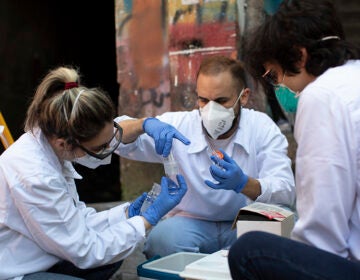New blood test for pregnant women could predict preterm birth
In 2016, one in 10 babies in the U.S. were born before 37 weeks of pregnancy. Worldwide, preterm birth complications are the leading cause of death for children under 5

A doctor holds a stethoscope on a pregnant person's belly. (VadimGuzhva/Bigstock)
In 2016, one in 10 babies in the U.S. were born before 37 weeks of pregnancy, according to the Centers for Disease Control and Prevention. Worldwide, preterm birth complications are the leading cause of death for children under 5, according to the World Health Organization.
In general, African-American women and those who have had preterm births before are considered at higher risk for early delivery, but there’s not a dependable universal test.
“The current standard is — in the simplest terms — we guess,” said Dr. Michal Elovitz, a professor of obstetrics and gynecology at the University of Pennsylvania.
There are two tests to tell whether a woman is a risk for a preterm delivery, but they’re not as good as we’d like them to be, said Mira Moufarrej, a doctoral candidate in bioengineering at Stanford University.
“Those tests are really good at saying if a woman will not deliver preterm — meaning that if the test comes back negative, it is very likely that a woman is not going to deliver preterm,” she said. “But they are terrible at telling if a woman will deliver preterm — meaning that if the test comes back positive, we’re not sure what that means.”
Elovitz and Moufarrej are part of a team of researchers who came up with a blood test to tell if a woman is going to deliver early. They published their findings in the journal Science.
If a woman is going to have a preterm delivery, the test will show seven specific cell-free RNA molecules that correspond to particular genes in much higher levels.
“It accurately identified in the paper four (out) of five preterm samples, “ said Elovitz. “So 80 percent in our world when we … can’t even flip a coin and predict preterm birth, 80 percent is tremendous.”
Stressing it’s just the first step, both researchers said they need to test this technique in a much larger group before it can be applied in hospitals.
The study design and methods are excellent, said Dr. Michael Greene, a professor of obstetrics and gynecology and reproductive biology at Harvard Medical School, was not involved in this study. The fact that the team has replicated their findings in another data set makes their conclusions more credible, he added.
“The technology that they are exploring may turn out to be extremely helpful and productive,” Greene said. “But, as the authors acknowledge themselves in their paper, what they have so far is extremely preliminary and far away at this point from being usable in a clinical setting.”
Much more research on preterm births is needed, he said.
“Having a screening test is maybe nice, but … it’s only truly useful if you have an effective intervention that you can offer,” Greene said. “Part of the problem we have right now is there’s no real silver bullet for preventing preterm birth even when we identify correctly women who are high risk.”
And there’s another question. “One of the issues that comes up that gets debated over beers all the time at meetings: Is or are the trigger or triggers for term birth the same as the triggers for preterm birth?” he said. “And we can debate that for the rest of the month.”
WHYY is your source for fact-based, in-depth journalism and information. As a nonprofit organization, we rely on financial support from readers like you. Please give today.





